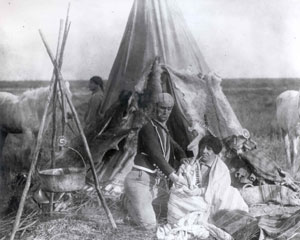ONÉSIME SUR LE SENTIER DE LA GUERRE
(Onésime peau rouge)
Jean Durand (FR 1913)
Gaumont’s “Onésime” comedies featured Ernest Bourbon as a skillful acrobat, lean and slightly stooped, with an unusually expressive face (highlighted by a sharp nose, grinning mouth, and malicious little eyes). Overall, the series was marked by frenetic action, throw-away reflexivity, and the freewheeling invention of absurd situations. This film is no exception.
The slight story has Onésime, as a well-to-do city slicker, invited to Mexico and tasked with using fireworks to disrupt the upcoming wedding of Carmencita, the daughter of Olavacca, to the villainous Señor Gomez. Hero and heroine fall in love, of course, and Gomez has nearby Indians abduct Carmencita, beat up and scalp Onésime, and then take him captive as well. In the end, attracted by the promised fireworks, the Indians free Onésime, and the lovers are reunited and return to the city.
In its parody of cowboy and Indian pictures, the film runs off a series of incongruous riffs, in both the scenes and intertitles. Gomez, for instance, wields a threatening knife at Onésime but is no more “courageous than a rabbit.” The Indian tribe is called Pieds à l’Huile or Slimy Feet, and their chief, appropriately named Escargot du Désert or Desert Snail, keeps upping the sum of money Gomez has to pay him for his revenge. That revenge ends with Onésime trussed up on a roasting pit over a fire, as one Indian bastes him and slices off pieces of “white” meat to have the chief taste – he dislikes the first bite. The fireworks display is staged in a strangely “Oriental” tent setting, and a spinning fire wheel leads to a huge explosion that destroys the Indian village. The ending “family portrait,” of course, has to provoke one last gag.
Richard Abel

cast: Alberto Collo (Giovanni Fargas), Oreste Grandi (Alonzo), Matilde Di Marzio (Matilde Gallegos), ? (Fedro), ? (José).
prod: Cines.
uscita/rel: 04.12.1914.
copia/copy: 35mm, 486 m., 25’27″(16 fps), col. (imbibito e virato/tinted & toned); did./titles: NLD.
fonte/source: EYE Filmmuseum, Amsterdam (Desmet Collection).


 Italiano
Italiano